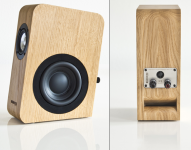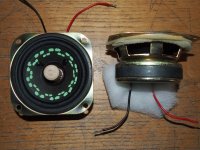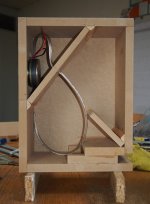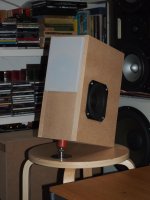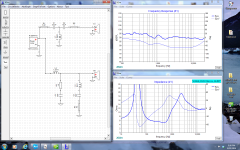The Ellam box. Its a 10.7L, port is about 2inch x 6 inch.
This is about what I am looking for. For now I want to keep the design simple as I am not good at woodworking, and I can finish the speaker and have it ready for playing Christmas music.
The box and crossover can be upgraded in the future.
So, I am looking at a 0.38 cu ft box, port 2 inch x 6 inch, using the Ellam as an example.
I am going to look at the other suggestions and do some simulations.
"Are we hacking this thread ? Hope not ; like the communication !"
Its all fine.
Cheers
This is about what I am looking for. For now I want to keep the design simple as I am not good at woodworking, and I can finish the speaker and have it ready for playing Christmas music.
The box and crossover can be upgraded in the future.
So, I am looking at a 0.38 cu ft box, port 2 inch x 6 inch, using the Ellam as an example.
I am going to look at the other suggestions and do some simulations.
"Are we hacking this thread ? Hope not ; like the communication !"
Its all fine.
Cheers
I once had good luck using an 8 inch driver with a shorted voice coil as a passive radiator, along side an active 8 inch woofer, in a relatively small sealed box. But it may have involved some beginners luck.
Now days'I highly prefer a closed box with active EQ to make it acoustically flat down to 30HZ (with a steep electronic dropoff below that). Getting a port ro be tuned properly takes some work. Making it too small, in order to have a smaller box, can cause the port to make noise.
Using a high cost driver that has substantial peaking in the upper midrange, right where the ear is most sensitive, means the crossover will need a difficult to design and verify zobel network. Maybe even more than one. If you don't have all the required test equipment and really know what you're doing, it's not something I would ever recommend messing with.
IMO, your Scan-Speak 15W8531K00 could make a decent woofer but its response takes off at around 1kHZ and gets worse from there. I wouldn't use it above about 500HZ. I'd put it with a Peerless 3 inch TG or Vifa TC driver (in it's own sub-enclosure), crossed at 500HZ and let the TG driver do everything above 500HZ.Sorry if this sounds condescending. Many people don't get that the frequency response graph is one of the most important things about any driver. Peaking in the upper midrange is arguably the worse thing you can have in a speaker. A sense of presence will seem better at first, but ten minutes later your brain will hurt.
Now days'I highly prefer a closed box with active EQ to make it acoustically flat down to 30HZ (with a steep electronic dropoff below that). Getting a port ro be tuned properly takes some work. Making it too small, in order to have a smaller box, can cause the port to make noise.
Using a high cost driver that has substantial peaking in the upper midrange, right where the ear is most sensitive, means the crossover will need a difficult to design and verify zobel network. Maybe even more than one. If you don't have all the required test equipment and really know what you're doing, it's not something I would ever recommend messing with.
IMO, your Scan-Speak 15W8531K00 could make a decent woofer but its response takes off at around 1kHZ and gets worse from there. I wouldn't use it above about 500HZ. I'd put it with a Peerless 3 inch TG or Vifa TC driver (in it's own sub-enclosure), crossed at 500HZ and let the TG driver do everything above 500HZ.Sorry if this sounds condescending. Many people don't get that the frequency response graph is one of the most important things about any driver. Peaking in the upper midrange is arguably the worse thing you can have in a speaker. A sense of presence will seem better at first, but ten minutes later your brain will hurt.
Bob, thanks for the heads up. I have measurement equipment, although it is not perfectly calibrated, and know just enough to get myself into trouble. I am going to give it a try. There is no turning back  .
.
Interesting to know this popular driver is good up to 500hz, and needs work and attention to the crossover. I will pay attention to the peaking mid range.
So, this means no simple crossover perhaps.
Interesting to know this popular driver is good up to 500hz, and needs work and attention to the crossover. I will pay attention to the peaking mid range.
So, this means no simple crossover perhaps.
Dear Bob ,
Troels did a real great job by notching the (slight) midrange peak.
There is no such thing as the perfect driver & Im on the digital approach myself.
If you are planning the 15w as a woofer in a Fast , then take a look at the Fountek FE 85 ; a 10 dollar (yes 10 dollar !!) driver with the most lineair fr. curve I've ever seen. Sven Boenicke used it in his W5. (see pics).
I recently did a form/concept clone of the W5 and it sounds great........after I kicked out the FE85 and put in an old Foster 085 k ; less lineair but sound wise more pleasing !!
Everybody listens in it's own way !
Building speakers is about creating YOUR sound !!
Troels did a real great job by notching the (slight) midrange peak.
There is no such thing as the perfect driver & Im on the digital approach myself.
If you are planning the 15w as a woofer in a Fast , then take a look at the Fountek FE 85 ; a 10 dollar (yes 10 dollar !!) driver with the most lineair fr. curve I've ever seen. Sven Boenicke used it in his W5. (see pics).
I recently did a form/concept clone of the W5 and it sounds great........after I kicked out the FE85 and put in an old Foster 085 k ; less lineair but sound wise more pleasing !!
Everybody listens in it's own way !
Building speakers is about creating YOUR sound !!
Attachments
and some more pics of my construction.
I can do an design on the same basics for the 15w !
best pc speakers I've ever heard !!
BTW ; tweeter on the back for ambient sound ; I like !!
profitable 2 clone ; original price is about 3500 the set !!
I can do an design on the same basics for the 15w !
best pc speakers I've ever heard !!
BTW ; tweeter on the back for ambient sound ; I like !!
profitable 2 clone ; original price is about 3500 the set !!
Attachments
Hi Lojzek,Jack,
With 2" in diameter, the length of the port would be around 12"
and you would probably need to find a solution ( elbow) to fit one.
This was simulated using Woofer Box and Circuit designer.
Jeff Bagby's Software Page
With the right XO filter it would sound very good.
I did a quick simulation using the software on the port, using 0.38 cu ft box, 2 inch port. It still needs a rather long port, but it seems the Ellam-XT box works just fine with a shorter 6 inch port.
The manufacturer spec states a 0.35 cu ft box with 1.5 inch x 6" long port for F3 of 50hz.
Any suggestions? Perhaps a bit higher port response works out fine. Then I don't normally play music loud, so a 1.5 inch port might work fine here.
The manufacturer spec states a 0.35 cu ft box with 1.5 inch x 6"
long port for F3 of 50hz.Any suggestions? Then I don't normally
play music loud, so a 1.5 inch port might work fine here.
Hi Jack,
I suggest you do 1,5" by 6". F3=45; F6=38 and F10=33 Hz according
to sim in a 0,35 cu ft box. F6 and F10 are important for better bass
and these are 10 Hz lower than with 2" by 6". You will do fine.
Last edited:
See if Zaph's write-up for his ZD5 can give you a little more insight into the driver: Zaph|Audio - ZD5 - Scan Speak 15W8530K00 and Vifa XT25.
Here's a look at another implementation: The Carreras
If you can find one of those xo points suitable to your Usher tweeters and if the baffle size and placements match, you shouldn't have any problem at all using one of those xo's on the woofer.
And once you get it dialed in, it will be more than worth it: that woofer is an industry high-end standard. I have the ZD5's. They are magical.
Here's a look at another implementation: The Carreras
If you can find one of those xo points suitable to your Usher tweeters and if the baffle size and placements match, you shouldn't have any problem at all using one of those xo's on the woofer.
And once you get it dialed in, it will be more than worth it: that woofer is an industry high-end standard. I have the ZD5's. They are magical.
@ Speakerdocter ; hope this will be of any help : Ellam-XT
Sorry ; my english is a bit "rusty" .
Here is my simmed xover based on Troel's EllamXT design.
Of course, the .frd and .zma files I used are begged, borrowed and stolen (so to speak) from around the web. But the sim's FR and Imp. output came pretty close to Troel's measurements. Not bad. I may give this a try.
Attachments
It seems that both the Ellam-XT and the Carrera use a very similar notch filter, roughly 3mh, 20uf, and 10 ohms to deal with the 800hz peak. Both woofer filters are quite similar.
There are 3 xover parts just to deal with one alledged response hump. My 15W/8530K01's don't have that hump in the primary response. Visit my Intimates link at Parts Express tech talk forum and examine my HolmImpulse tests. There is a hump in the vent response around 800 hz but it doesn't manafest itself in the measurable 1M FR.
Also note the entire Intimates crossover has only 3 parts!
There are 3 xover parts just to deal with one alledged response hump. My 15W/8530K01's don't have that hump in the primary response. Visit my Intimates link at Parts Express tech talk forum and examine my HolmImpulse tests. There is a hump in the vent response around 800 hz but it doesn't manafest itself in the measurable 1M FR.
Also note the entire Intimates crossover has only 3 parts!
I looked at your XO briefly, and looks like there is sure no 800hz peak. You have achieved a good result with low part count.
Are you building the Ellam-XT crossover for comparison? Or just doing simulation?
If it is possible, can you post a simulation of both woofers only with their XOs, perhaps superimpose them for comparison?
I am curious about the XO with high part count vs low part count, and looks like Zaph used even more parts for the crossover, but his XO is an LR2, and he chose to have a bit more flat freq response(vs Ellam's bit of downward slope), if I look at it correctly. I am sure all of those crossovers work well.
I looked at your XO briefly, and looks like there is sure no 800hz peak. You have achieved a good result with low part count.
Are you building the Ellam-XT crossover for comparison? Or just doing simulation?
If it is possible, can you post a simulation of both woofers only with their XOs, perhaps superimpose them for comparison?
I am curious about the XO with high part count vs low part count, and looks like Zaph used even more parts for the crossover, but his XO is an LR2, and he chose to have a bit more flat freq response(vs Ellam's bit of downward slope), if I look at it correctly. I am sure all of those crossovers work well.
I don't have .frd file for the 15W/8530K01, just the K00 and I've been using that. So, I cannot do as you ask. Looking at both Scanspeak's 00 and 01 FR curves, they exhibit the 800 hz hump. Note how it becomes almost indistinquishable when you move off axis where most of us listen; at least a little bit. I'm not sure I'm going to bother with that shunt filter. In my sim with that xover, when I remove the shunt, the 1 kHz hump raises it's ugly head. Not sure we're just chasing SS's single test 'faires'. The best advice I can give is keep it as simple as possible for best sonic results.
I'm sure as well that Zaph's designs do sound great.
I'm building the XT crossover because I recently bought 2 Vifa XT25TG30-04 tweeters to try them out in my Intimates. When I get the installing one of them in place of the SS D2905, I'll create some new .frd's for the tweeter and 01 Revelator mid in my baffleboard when the most accurate models are created from; your own speaker. That won't happen for another week or so due to other committments.
Last edited:
http://www.diyaudio.com/forums/multi-way/55784-a4-monitor-best-mini-monitor.html
This speaker uses the mid-bass driver you have.
http://www.hifikit.se/hifi/a4-monitor
9 litre box.
http://www.troelsgravesen.dk/Ellam-FLEX.htm
This too.
I am presently making his older design the W1500/97 I think its called.
http://www.troelsgravesen.dk/W1500_97.htm
This speaker uses the mid-bass driver you have.
http://www.hifikit.se/hifi/a4-monitor
9 litre box.
http://www.troelsgravesen.dk/Ellam-FLEX.htm
This too.
I am presently making his older design the W1500/97 I think its called.
http://www.troelsgravesen.dk/W1500_97.htm
Last edited:
@ Speakerdocter : Your sims look OK !!
I'm very pleased to hear how the new version , classic x-over, compares soniccally to the AR-SXO version.
Maybe the sine-cap version is not the most lineair way to x-o but soundwise I like it MORE.
800~1k bump ; Agree with you ; off-axis it is not disturbing.
So I did NOT notch it ; getting all those extra parts soundwide right is a crime to do.
Please let me know ; I wasn't too impressed by the XT25.
I'm very pleased to hear how the new version , classic x-over, compares soniccally to the AR-SXO version.
Maybe the sine-cap version is not the most lineair way to x-o but soundwise I like it MORE.
800~1k bump ; Agree with you ; off-axis it is not disturbing.
So I did NOT notch it ; getting all those extra parts soundwide right is a crime to do.
Please let me know ; I wasn't too impressed by the XT25.
you might have more details on this your building. Thank youand some more pics of my construction.
I can do an design on the same basics for the 15w !
best pc speakers I've ever heard !!
BTW ; tweeter on the back for ambient sound ; I like !!
profitable 2 clone ; original price is about 3500 the set !!
Biagio
- Status
- This old topic is closed. If you want to reopen this topic, contact a moderator using the "Report Post" button.
- Home
- Loudspeakers
- Multi-Way
- Using Scan-Speak 15W8531K00

